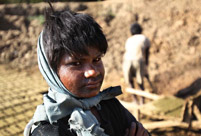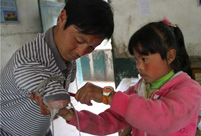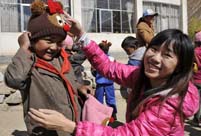Rome, October 17 - Rome hosted in 1937 the last major exhibit on Augustus, the Eternal City's first emperor who founded a new political, artistic and cultural era. Now, on the 2000th anniversary of his death on 19 August 14 AD, the Scuderie del Quirinale are hosting starting Friday through 9 February 2014, an extensive show with about 200 extraordinary pieces on loan from a number of museums worldwide to investigate both the emperor's charismatic political persona and the historic period he inspired with a new aesthetic language.
''I had been trying to organize this show for decades but never succeeded until now'', said the exhibit's curator Eugenio La Rocca, who was Rome's cultural heritage superintendent until 2008.
''It was a huge effort by all, given the times and the cost of such an operation'', said La Rocca, who organized the exhibit together with Claudio Parisi Presicce, Annalisa Lo Monaco, Cecile Giroire and Daniel Roger.
Augustus was a central figure in Fascist propaganda, continued the show's curator, and became an historic outcast after World War II.
Recent studies have been able to strip Augustus' figure of the Fascist polish given to him during the two-decade-long regime in Italy.
Emperor Octavian Augustus was a man of great strength and guile, who successfully fought against rivals striving like him to gain absolute power.
He eventually went as far as deifying his persona - an aspect highlighted by the exhibit which opens and closes with the apotheosis of the emperor after his death.
At the centre of the show is the life and struggles of the adopted son and great-nephew of Julius Caesar, the only man who was able to end bloody infighting that had consumed the Roman Republic for decades and inaugurate a new political season for the Empire.
He ruled for over 40 years, the longest period in Rome's history, during which the Empire achieved its greatest expansion.
The exhibit unveils different aspects of an era which had a millennial impact on Western civilization through a number of masterpieces coming from museums and private collections, some of which have never been exhibited in Italy.
A number of stunning pieces come from the Louvre Museum in Paris which cooperated with the Scuderie del Quirinale for the show.
''After this Rome edition, 'Augustus' will go to the Grand Palais'' in Paris, said La Rocca. ''The support granted by French museums was fundamental'', he noted, adding that the Louvre bestowed its collections as part of this effort.
Artwork of great beauty and importance includes celebrated statues of Augustus showcased together for the first time such as the emperor as Pontifex Maximus from Via Lubicana, now at the Palazzo Massimo alle Terme, and Augustus of Prime Porta from the Vatican Museums, a Roman symbol par excellence.
La Rocca placed it besides its classical model, the Doryphoros from the Archaeological Museum in Naples, an example of Classical sculptural perfection, to show the evolution of a new iconographic language elaborated during the emperor's rule.
Culture during the Augustus era focused on the Greek world yet developed a different style which did not belong to Classicism but had its own innovative imprint and would become a source of inspiration in centuries to come, from the Napoleonic era to Fascism.
A bronze equestrian statue of the emperor on loan from the Athens Museum is shown for the first time in Italy. It was found at the bottom of the Aegean sea.
A splendid bronze portrait now part of the British Museum's collection hails from Meroe, Nubia, in Egypt.
Busts of the emperor's wife Livia, sister Octavia, nephews Marcello, Lucius Caesar and Gaius Caesar, adopted to guarantee an heir to Rome's throne who died at a young age, are placed besides artwork exemplifying the idealization of the emperor.
A sculpted head which is thought to represent the last queen of Egypt Cleopatra, a staunch enemy of the emperor, shows the era's fascination with Egypt.
The New Classicism that saw the light under Augustus can be admired throughout the exhibit in sculptures and decorative arts including a selection of silver pieces from the Boscoreale treasure loaned by the Louvre.
The Grimani bas-reliefs represent animals as they are breastfeeding their puppies, brought together exceptionally for the exhibit from the Kunsthistoriches Mueum in Vienna and the Museum of Palestrina. The group of the Niobids, an original Greek sculpture from a temple front set up during Augustus' era in Rome's Horti Sallustiani has been recomposed here by placing two statues from the Ny Carlsberg Glyptotek in Copenhagen besides the statue of an injured girl from the Museo Nazionale Romano.
The exhibit ends with an unprecedented reconstruction of 11 bas-reliefs from a monument originally built in the southern Italian Campania region to commemorate Augustus after his death, which is today divided into two separate collections in Spain and Hungary.
The artwork tells the story of the naval battle of Actium in 31 B.C. which ended the civil war between Octavian and Mark Anthony and ultimately paved the way for the triumph of the Roman 'princeps'.
 Low wages Indian migrant laborers
Low wages Indian migrant laborers Five fighters in flight training
Five fighters in flight training London mayor hails free trade, subway system on China tour
London mayor hails free trade, subway system on China tour Different eye catching shows at housing fairs in China
Different eye catching shows at housing fairs in China Chalk it up to great courage
Chalk it up to great courage Tibetan girl helps mobilize volunteers onlin
Tibetan girl helps mobilize volunteers onlin Lingerie show dazzles Wuhan Motor Show 2013
Lingerie show dazzles Wuhan Motor Show 2013  Chinese screen goddesses from Beijing Film Academy
Chinese screen goddesses from Beijing Film Academy  Weekly Sports Photos
Weekly Sports Photos Chinese riot police take Liberia peacekeeping mission
Chinese riot police take Liberia peacekeeping mission World has never been dark-- a blind kid’s life in Tibet
World has never been dark-- a blind kid’s life in Tibet Change to law may make it easier to sue polluters
Change to law may make it easier to sue polluters UNESCO world heritage site: Montale Tower
UNESCO world heritage site: Montale Tower U.S. Senate leader announces bipartisan deal
U.S. Senate leader announces bipartisan deal Fiber-optic wedding dress show shinning in Suzhou
Fiber-optic wedding dress show shinning in Suzhou Day|Week|Month